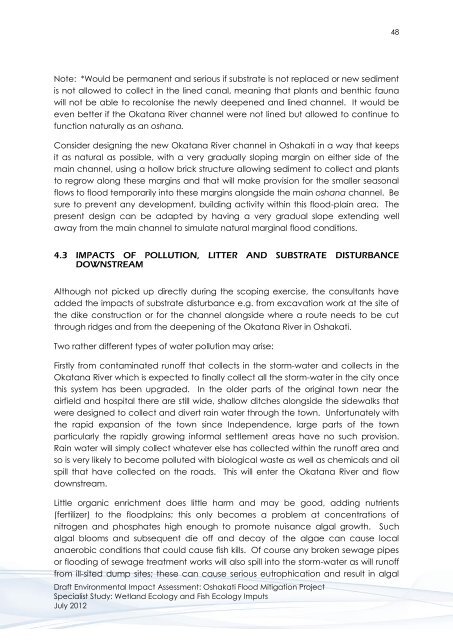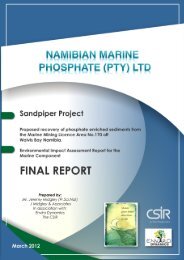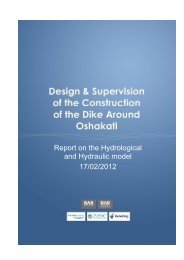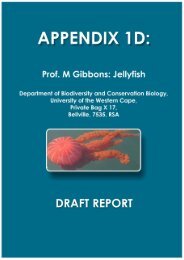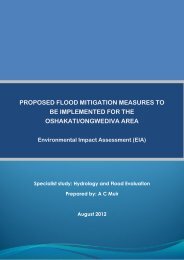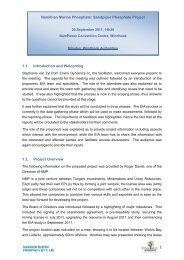Wetland & Fish Ecology - Enviro Dynamics Namibia
Wetland & Fish Ecology - Enviro Dynamics Namibia
Wetland & Fish Ecology - Enviro Dynamics Namibia
You also want an ePaper? Increase the reach of your titles
YUMPU automatically turns print PDFs into web optimized ePapers that Google loves.
48<br />
Note: *Would be permanent and serious if substrate is not replaced or new sediment<br />
is not allowed to collect in the lined canal, meaning that plants and benthic fauna<br />
will not be able to recolonise the newly deepened and lined channel. It would be<br />
even better if the Okatana River channel were not lined but allowed to continue to<br />
function naturally as an oshana.<br />
Consider designing the new Okatana River channel in Oshakati in a way that keeps<br />
it as natural as possible, with a very gradually sloping margin on either side of the<br />
main channel, using a hollow brick structure allowing sediment to collect and plants<br />
to regrow along these margins and that will make provision for the smaller seasonal<br />
flows to flood temporarily into these margins alongside the main oshana channel. Be<br />
sure to prevent any development, building activity within this flood-plain area. The<br />
present design can be adapted by having a very gradual slope extending well<br />
away from the main channel to simulate natural marginal flood conditions.<br />
4.3 IMPACTS OF POLLUTION, LITTER AND SUBSTRATE DISTURBANCE<br />
DOWNSTREAM<br />
Although not picked up directly during the scoping exercise, the consultants have<br />
added the impacts of substrate disturbance e.g. from excavation work at the site of<br />
the dike construction or for the channel alongside where a route needs to be cut<br />
through ridges and from the deepening of the Okatana River in Oshakati.<br />
Two rather different types of water pollution may arise:<br />
Firstly from contaminated runoff that collects in the storm-water and collects in the<br />
Okatana River which is expected to finally collect all the storm-water in the city once<br />
this system has been upgraded. In the older parts of the original town near the<br />
airfield and hospital there are still wide, shallow ditches alongside the sidewalks that<br />
were designed to collect and divert rain water through the town. Unfortunately with<br />
the rapid expansion of the town since Independence, large parts of the town<br />
particularly the rapidly growing informal settlement areas have no such provision.<br />
Rain water will simply collect whatever else has collected within the runoff area and<br />
so is very likely to become polluted with biological waste as well as chemicals and oil<br />
spill that have collected on the roads. This will enter the Okatana River and flow<br />
downstream.<br />
Little organic enrichment does little harm and may be good, adding nutrients<br />
(fertilizer) to the floodplains; this only becomes a problem at concentrations of<br />
nitrogen and phosphates high enough to promote nuisance algal growth. Such<br />
algal blooms and subsequent die off and decay of the algae can cause local<br />
anaerobic conditions that could cause fish kills. Of course any broken sewage pipes<br />
or flooding of sewage treatment works will also spill into the storm-water as will runoff<br />
from ill-sited dump sites; these can cause serious eutrophication and result in algal<br />
Draft <strong>Enviro</strong>nmental Impact Assessment: Oshakati Flood Mitigation Project<br />
Specialist Study: <strong>Wetland</strong> <strong>Ecology</strong> and <strong>Fish</strong> <strong>Ecology</strong> Imputs<br />
July 2012


